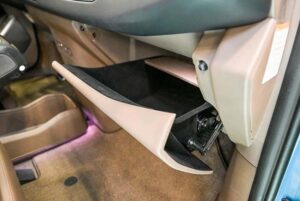Hyundai Mobis has announced the launch of a glovebox specifically designed for electric vehicles (EVs) with first application in Kia’s large electric SUV, the EV9.
 This ‘parabolic motion’ glovebox includes an expanded glovebox capacity and a user-friendly design, which minimizes the risk of knee collision when the glovebox is opened.
This ‘parabolic motion’ glovebox includes an expanded glovebox capacity and a user-friendly design, which minimizes the risk of knee collision when the glovebox is opened.
According to Hyundai Mobis, the ‘Parabolic Motion Glovebox’ is a concept inspired by the aircraft overhead bin. ‘Parabolic motion’ alludes to the parabolic trajectory, mirroring the path followed by overhead airplane luggage compartments. The moniker underscores its distinct motion pattern, a stark contrast to the straightforward rotation or covers opening-type gloveboxes found in traditional vehicles.
In automotive terminology, a ‘glovebox’ is a compartment near the passenger’s knee, typically storing items such as car manuals, tissues, sunglasses, and foldable umbrellas. It is one of the most oversized compartments available in a car for storing small items.
Given that the design and composition of recently developed EV deviate from those of conventional internal combustion vehicles, Hyundai Mobis’ EV-specific glovebox benefits from additional interior space. Eliminating an engine room in EVs broadens passenger space, facilitating an expansion in the glovebox’s storage capacity to 8 litres.
In its quest to optimise the glovebox for EVs, Hyundai Mobis has significantly enlarged its storage capacity. Conventional internal combustion vehicles typically offer a glovebox capacity of around 5.5 litres.
However, by adopting the parabolic-motion approach, this capacity stands augmented to over 8 litres. Consequently, this increase allows the storage of more and more oversized items than traditional internal combustion vehicle gloveboxes. Apart from boosting capacity, usability has been enhanced, including simplified item retrieval and insertion and reducing knee collision instances when the glovebox is opened.
Interestingly, Hyundai Mobis’ latest technological breakthrough originated from an in-house idea contest. This inventive concept won a gold medal in the 2021 internal idea contest, eventually evolving into a tangible product that led to mass production. Since 2019, the company has been fostering a culture of voluntary and creative R&D among its employees, having already accumulated over 3,200 ideas to date as of the first half of this year.
Choi Jae-seob, Head of Trim Module Engineering Sector at Hyundai Mobis, emphasized the importance of reinterpreting passenger space for future mobility, stating, “We are committed to the continuous development of bespoke technologies that prioritize user experience.”
